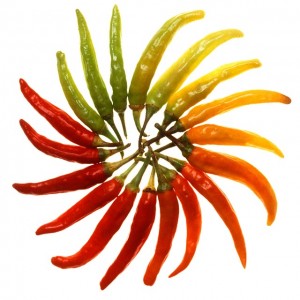This week one of our Facebook group members posted a link to a 2013 paper entitled “Love thy neighbour: facilitation through an alternative signalling modality in plants”. The premise in the paper is that plants are capable of acoustic communication and the experiment purported to demonstrate this. (I strongly encourage you to download the article from the link above so you can read it for yourself.)
 Briefly, chile seeds (Capsicum annuum) were placed into petri dishes, covered to ensure darkness, and then the dishes were placed in a circle. In the middle of the circle was either an empty acrylic box covered in black plastic (the control), an acrylic box covered in black plastic containing an adult basil plant (Ocimum basilicum) called the masked treatment, or an adult basil plant without a box (the open treatment). Seeds were watered and inspected daily for germination and the petri dishes were randomly rearranged.
Briefly, chile seeds (Capsicum annuum) were placed into petri dishes, covered to ensure darkness, and then the dishes were placed in a circle. In the middle of the circle was either an empty acrylic box covered in black plastic (the control), an acrylic box covered in black plastic containing an adult basil plant (Ocimum basilicum) called the masked treatment, or an adult basil plant without a box (the open treatment). Seeds were watered and inspected daily for germination and the petri dishes were randomly rearranged.
 According to the authors, “the presence of basil positively enhanced germination rates of chilli seeds, validating the claims of many gardeners who recognise the beneficial effect of basil on the growth of chilli plants.” Their reasoning is that the open and masked treatments induced more seed germination than the control. And since there was little difference between the masked and open treatments, they claim that the phenomenon is due to some signal other than light or gas (since the black plastic-covered acrylic container would prevent this).
According to the authors, “the presence of basil positively enhanced germination rates of chilli seeds, validating the claims of many gardeners who recognise the beneficial effect of basil on the growth of chilli plants.” Their reasoning is that the open and masked treatments induced more seed germination than the control. And since there was little difference between the masked and open treatments, they claim that the phenomenon is due to some signal other than light or gas (since the black plastic-covered acrylic container would prevent this).
How does this work? Well, according to the authors, this is evidence that acoustic signals are “generated in plants by biochemical processes within the cell, where nanomechanical oscillations of various components in the cytoskeleton can produce a spectrum of vibrations.” Never mind that the experimental design and methodology was laden with opportunities for experimental error. In particular, opening the petri dishes to water and count germinated seeds every day is deeply flawed. The easiest and least error-prone method would be to have the petri dishes sealed with parafilm to prevent water loss and inspected ONLY after the experiment was over. That is the standard method for testing for germination rates. Moreover, opening the dishes to count and water seeds every day really screws up the “covered to ensure darkness” part. In fact, chile seeds germinate better with light – which is what they got every day when they were opened. Was each dish exposed to light for exactly the same time every day? Exposure to light converts the seeds’ phytochrome to what’s called the active form, and phytochrome plays a crucial role in seed germination. The longer the light exposure, the more phytochrome is converted.
 Now, plant scientists would know these things when they were designing their experiments. But as neither of the authors have degrees in plant sciences, it’s understandable. What’s not understandable is how this article got through peer-review. Unless none of the reviewers were plant scientists, either.
Now, plant scientists would know these things when they were designing their experiments. But as neither of the authors have degrees in plant sciences, it’s understandable. What’s not understandable is how this article got through peer-review. Unless none of the reviewers were plant scientists, either.
For those of you that belong to a university journal club or some other science discussion group, I think this would be a great article to discuss.
The tiny effect is probably a result of moisture, light, and handling, as true controls would have shown. Moving them around randomly rather than using a properly randomized and replicated design, combined with no attempt to make handling and assessments blind, and lack of objective, evidence-based interpretations in the conclusions makes this my new example to hand out in my stats class on how not to do it.